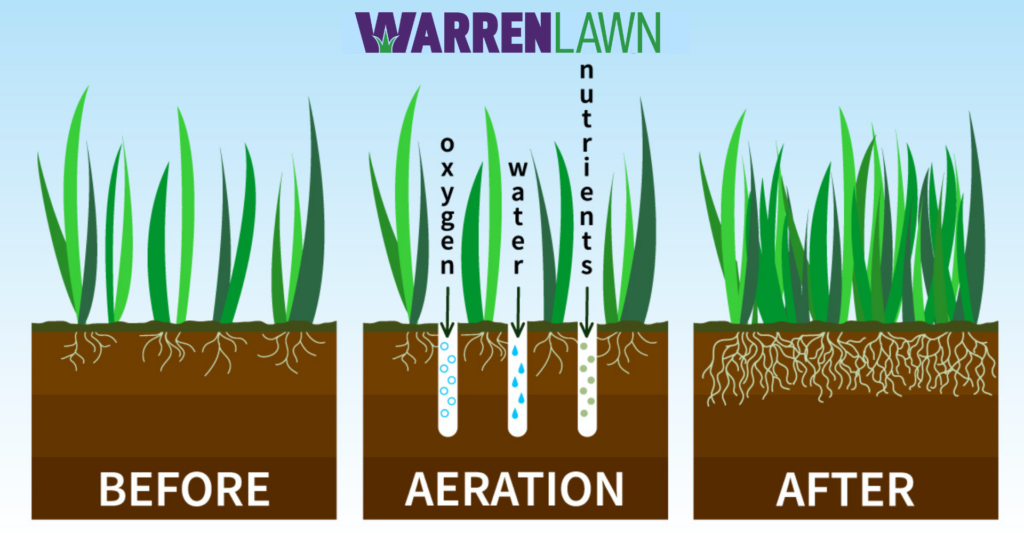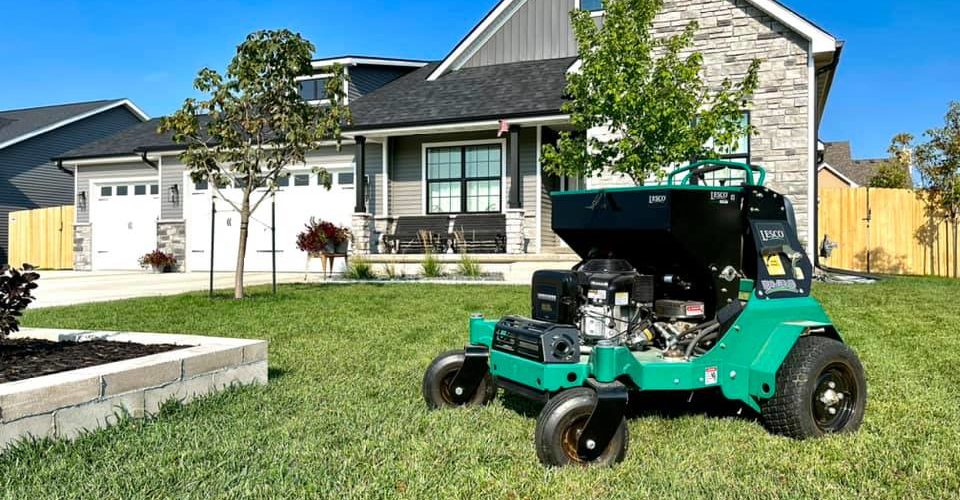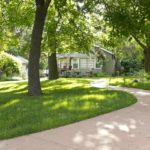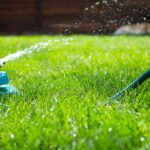When it comes to the overall health of your lawn, there are 5 factors that come into play. Four of those five would be; proper mowing, proper irrigation, pest control and fertilization. All of those will play an important role in the health of your lawn. Number five, and most importantly, would be aeration and overseeding. This could also be classified as cultivation. The act of working up the compacted soil and then overseeding with appropriate seed.
How do you know if aeration and overseeding right for your lawn? When should you do it? What type of seed should you use? How often should you do it? There are many questions to discuss, so let’s dive right in.

Definition 📃
First, it is important to understand what aeration is. To begin, it is pronounced “Air-ation”. A common mispronunciation would be “Air-e-ation”. Now let’s consider what actually happens. When a lawn is aerated, a core of the ground is pulled out and set aside. The purpose of pulling the core out of the ground as seen in the image above, is 4-fold. Pulling thousands of cores out of the ground will allow oxygen, water and nutrients to soak down into the soil easier. All of these will contribute to compaction release. A compacted lawn is when your lawn soil gets packed down due to weather conditions, foot traffic, mowing and more. Allowing proper water and oxygen flow will allow the compaction to be released. Removing the core from the ground, also allows more room for the root system of your grass to spread. The greatest factor in the health of your grass is the health of its root system. The deeper and more robust the root system, the better your grass above ground will be. The core that gets removed will then disintegrate and all the nutrients from it will go right back into the lawn, so it isn’t necessary to rake them up.
Timing ⏰
Now that we have defined what aeration is, the next step is to determine when this needs to take place. In theory, aerating your lawn can take place at any time of the year. Your lawn loves it when you aerate, and it is not partial to any specific time. However, when you incorporate overseeding, the absolute best time would be in Fall. The second best time would be in the Spring.
Grass seed can be a very particular plant, and it wants the proper environment in order to germinate, or grow. The ideal conditions for seed to grow would be damp conditions, with cool temperatures in the night, and warm temperatures during the day. Once seed has these proper conditions, most varieties of seed will germinate within 7-14 days, depending on what type of seed you applied. So how do we provide these conditions?
During the Fall, beginning in September and going into the beginning of November, the nights begin to cool and the days remain warm. This warming and cooling temperature range is exactly what the seed needs in order to germinate. The second thing seed needs is proper moisture. If the seed doesn’t stay damp or receive the proper amount of moisture, it will not have a good chance of germination. After seed has been applied to your lawn, it is important to make sure that it receives this water on a regular basis. This can either be from rain or from you. The seed only needs to stay damp however, there is no need to over apply water and drown the seed. Watering once in the morning for about 15 minutes and once in the evening for 15 minutes, will be the proper amount of water for the seed to stay damp. The only exception to this rule would be if the days are getting very warm and dry. In this case, you would want to up your watering time.
Seed Type to Use 🌱
There are many different types of grass seed blends you can purchase that exist today. If you live anywhere in the upper midwest however, there are only a few varieties that will serve you best. These grass seed blends are called “cool season” grasses. These types of grass seed blends will survive best in the type of climate we have here in Iowa. The grass has to be able to handle the heat of the Summer and the bitter cold temperatures of the Winter. If you took a “warm season” grass variety, like a Zoysia or Bermuda, these grass types would suffer in our climate, because they only survive in climates where the temperatures stay warm year round.
There are 3 main cool season grass types that will work. These are Fescue, Kentucky Bluegrass and Rye. Within these three types of grass, there are sub groups of grasses. Each type will have many different sub types that are different varieties that have been grown for different purposes. All three of these grass types will grow well in your lawn here in Iowa. An entire blog could be written just about grass, however without getting into the weeds too much (no pun intended), we highly recommend using only 2 of these three.
Kentucky Bluegrass and Turf Type Tall Fescue are going to be the best blends of seed to be using in your lawn. Even though Ryegrass germinates very quickly, we exclude it because Rye is very sensitive to draught, disease and stress. If you plan on using your lawn at all, Ryegrass will not give you the best results. Turf Type Tall Fescue and Kentucky Bluegrass perform much better and have a much better ability to handle draught stress, diseases and traffic. At Warren Lawn, we highly suggest using a blend of one of these two types of grasses, or just using a blend of Turf Type Tall Fescue all by itself.
Why Aerate and Overseed? 🤷🏽♂️
Now that you are informed on what aeration and overseeding is, the ultimate question is why should you do it? As discussed earlier, aeration by itself has amazing health benefits both for your soil, and for the roots of your grass. Done by itself, it will always be beneficial. However, when combined with overseeding, you are not only bringing all the health benefits to your lawn, but you are also giving it new grass to help fill in any bare spots you have, providing it with fresh, strong grass varieties that will live on.
Overseeding over time, season after season, will thicken up your lawn. Making your lawn thick with the right grass varieties isn’t just a great thing to look at it, but making your lawn thick helps it fight against weeds and disease. When a lawn is thick, it can outcompete weeds that try to come in and take over, and it can fight out disease that tries to sneak in. The best first line of defense your lawn has, is its own health and thickness. With a deep root system, healthy soil and dense cover, it can do a lot of the weed control for you.
If you would like further information about aeration and overseeding for your own property, or if you have more questions about the service, contact us at Warren Lawn. We would love to answer any questions you have. Whether we do business with you or not, we want you to be successful this season!




Ron Snyder - August 8, 2022
Adam,
You are planning on aeration and overseeding correct?
admin - August 19, 2022
Yes sir, we have you on the schedule!
Ron Snyder - August 8, 2022
Is dethatching included or do I need to do that?
admin - August 19, 2022
Hi Ron, dethatching is one of the few lawn services that we do not offer. You are welcome to dethatch before the aeration as it would be a beneficial thing to do, but it is not required. Thanks!
Dianna Richardson - August 8, 2022
Will you aerate and over seed my yard? I would like to have that done. Thank you!
admin - August 19, 2022
Hi Dianna, absolutely. We will be in touch!